Safety Risk Analysis of a New Design of Basalt Fiber Gabion Slope Based on Improved 3D Discrete Element Method and Monitoring Data
Abstract
:1. Introduction
2. Tensile Test and Calibration
2.1. Tensile Test of BFR
2.2. Micro-Parameters Calibration
2.2.1. BFR
2.2.2. Soil
2.3. Uniaxial Compression Simulation of Gabion
3. 3D Discrete Element Modeling
3.1. Simulation of Seepage
3.2. BFR Gabion Slope
4. Analysis of Gabion Slope
4.1. Gabion Structure
4.1.1. Stress State
4.1.2. Sliding Analysis
4.2. Stability Analysis
4.2.1. Deformation Analysis
4.2.2. Stress Analysis
4.2.3. Porosity Analysis
5. Discussion
6. Conclusions
- The use of BFR in the gabion structure combines both advantages of BFR and traditional gabion structure. This new type of gabion structure is worthy of further promotion and application.
- The tensile test shows that the tensile strength of the BFR is 68.22 MPa. Under the action of uniaxial compression, the BFR gabion undergoes brittle fracture. Its peak stress is 6.83 MPa, and the corresponding axial strain is 0.65%.
- The FEM is used to calculate the hydraulic gradient to apply the seepage force for simulating the seepage effect in 3D DEM through the particle force analysis. The whole calculation process is simple and easy to program.
- After using BFR gabions, the safety factor of the slope has increased by 25.68% compared with the original slope. The failure of the BFR gabion slope is manifested as the dislocation of the gabions and bending of BFRs.
Author Contributions
Funding
Institutional Review Board Statement
Informed Consent Statement
Data Availability Statement
Acknowledgments
Conflicts of Interest
References
- Lambert, S.; Gotteland, P.; Nicot, F. Experimental Study of the Impact Response of Geocells as Components of Rockfall Protection Embankments. Nat. Hazards Earth Syst. Sci. 2009, 9, 459–467. [Google Scholar] [CrossRef]
- Lambert, S.; Heymann, A.; Gotteland, P.; Nicot, F. Real-Scale Investigation of the Kinematic Response of a Rockfall Protection Embankment. Nat. Hazards Earth Syst. Sci. 2014, 14, 1269–1281. [Google Scholar] [CrossRef] [Green Version]
- Green, R.; Lambert, C.; Watts, C.; Kennett, D.; Ryder, E. Development and Testing of a Modular Rockfall Protection Wall to Mitigate Earthquake-Induced Slope Hazards. In Proceedings of the 69th Highway Geology Symposium, Portland, ME, USA, 10–13 September 2018. [Google Scholar]
- Amato, G.; O’Brien, F.; Simms, C.K.; Ghosh, B. Multibody Modelling of Gabion Beams for Impact Applications. Int. J. Crashworth. 2013, 18, 237–250. [Google Scholar] [CrossRef]
- Gu, M.; Collin, J.G.; Han, J.; Zhang, Z.; Tanyu, B.F.; Leshchinsky, D.; Ling, H.I.; Rimoldi, P. Numerical Analysis of Instrumented Mechanically Stabilized Gabion Walls with Large Vertical Reinforcement Spacing. Geotext. Geomembr. 2017, 45, 294–306. [Google Scholar] [CrossRef]
- Tang, V.T.; Fu, D.; Ngoc Binh, T.; Rene, E.R.; Sang, T.T.T.; Singh, R.P. An Investigation on Performance and Structure of Ecological Revetment in a Sub-Tropical Area: A Case Study on Cuatien River, Vinh City, Vietnam. Water 2018, 10, 636. [Google Scholar] [CrossRef] [Green Version]
- Thompson, D.M.; Puklin, L.S.; Marshall, A.E. The Long-Term Impact of Channel Stabilization Using Gabion Structures on Zealand River, New Hampshire. Ecol. Eng. 2016, 95, 779–792. [Google Scholar] [CrossRef]
- Peyras, L.; Royet, P.; Degoutte, G. Flow and Energy Dissipation over Stepped Gabion Weirs. J. Hydraul. Eng. 1992, 118, 707–717. [Google Scholar] [CrossRef]
- Wüthrich, D.; Chanson, H. Aeration Performances of a Gabion Stepped Weir with and without Capping. Environ. Fluid Mech. 2015, 15, 711–730. [Google Scholar] [CrossRef] [Green Version]
- Fathi-moghaddam, M.; Sadrabadi, M.T.; Rahmanshahi, M. Numerical Simulation of the Hydraulic Performance of Triangular and Trapezoidal Gabion Weirs in Free Flow Condition. Flow Meas. Instrum. 2018, 62, 93–104. [Google Scholar] [CrossRef]
- Mohamed, H.I. Flow over Gabion Weirs. J. Irrig. Drain. Eng. 2010, 136, 573–577. [Google Scholar] [CrossRef]
- Lambert, S.; Bourrier, F. Design of Rockfall Protection Embankments: A Review. Eng. Geol. 2013, 154, 77–88. [Google Scholar] [CrossRef]
- Perera, J.S.; Lam, N.; Disfani, M.M.; Gad, E. Experimental and Analytical Investigation of a RC Wall with a Gabion Cushion Subjected to Boulder Impact. Int. J. Impact Eng. 2021, 151, 103823. [Google Scholar] [CrossRef]
- Ng, C.W.W.; Choi, C.E.; Su, A.Y.; Kwan, J.S.H.; Lam, C. Large-Scale Successive Boulder Impacts on a Rigid Barrier Shielded by Gabions. Can. Geotech. J. 2016, 53, 1688–1699. [Google Scholar] [CrossRef]
- Ng, C.W.W.; Su, Y.; Choi, C.E.; Song, D.; Lam, C.; Kwan, J.S.H.; Chen, R.; Liu, H. Comparison of Cushioning Mechanisms between Cellular Glass and Gabions Subjected to Successive Boulder Impacts. J. Geotech. Geoenviron. Eng. 2018, 144, 4018058. [Google Scholar] [CrossRef]
- Tokognon, C.A.; Gao, B.; Tian, G.Y.; Yan, Y. Structural Health Monitoring Framework Based on Internet of Things: A Survey. IEEE Internet Things J. 2017, 4, 619–635. [Google Scholar] [CrossRef]
- Jiang, Y.; Wang, X. Stress-Strain Behavior of Gabion in Compression Test and Direct Shear Test. In Proceedings of the Third International Conference on Transportation Engineering (ICTE 2011), Chengdu, China, 23–25 July 2011; pp. 1457–1462. [Google Scholar]
- Samayoa, J.; Baraccani, S.; Pieraccini, L.; Silvestri, S. Seismic Behavior of One-Storey Gabion-Box Walls Buildings. Front. Built Environ. 2018, 4, 7. [Google Scholar] [CrossRef] [Green Version]
- Nishold, S.S.P.; Sundaravadivelu, R.; Saha, N. Physical Model Study on Geo-Tube with Gabion Boxes for the Application of Coastal Protection. Arab. J. Geosci. 2019, 12, 164. [Google Scholar] [CrossRef]
- Cho, M.T.T.; Chueasamat, A.; Hori, T.; Saito, H.; Kohgo, Y. Effectiveness of Filter Gabions against Slope Failure Due to Heavy Rainfall. Soils Found. 2021, 61, 480–495. [Google Scholar] [CrossRef]
- Moss, A.; Kaiser, P.K. An Operational Approach to Ground Control in Deep Mines. J. Rock Mech. Geotech. Eng. 2022, 14, 67–81. [Google Scholar] [CrossRef]
- Cundall, P.A.; Strack, O.D.L. A Discrete Numerical Model for Granular Assemblies. Géotechnique 1979, 29, 47–65. [Google Scholar] [CrossRef]
- Bertrand, D.; Nicot, F.; Gotteland, P.; Lambert, S. Modelling a Geo-Composite Cell Using Discrete Analysis. Comput. Geotech. 2005, 32, 564–577. [Google Scholar] [CrossRef]
- Bertrand, D.; Nicot, F.; Gotteland, P.; Lambert, S. Discrete Element Method (DEM) Numerical Modeling of Double-Twisted Hexagonal Mesh. Can. Geotech. J. 2008, 45, 1104–1117. [Google Scholar] [CrossRef]
- Su, Y.; Cui, Y.; Ng, C.W.W.; Choi, C.E.; Kwan, J.S.H. Effects of Particle Size and Cushioning Thickness on the Performance of Rock-Filled Gabions Used in Protection against Boulder Impact. Can. Geotech. J. 2019, 56, 198–207. [Google Scholar] [CrossRef]
- Su, Y.; Choi, C.E. Effects of Particle Shape on the Cushioning Mechanics of Rock-Filled Gabions. Acta Geotech. 2021, 16, 1043–1052. [Google Scholar] [CrossRef]
- Su, Y.; Choi, C.E.; Lv, Y.R.; Wang, Y.; Li, X. Towards Realistic Simulations of the Impact Dynamics of Boulders on Rock-Filled Gabion: Combined Effects of Rock Shapes and Their Crushing Strength. Eng. Geol. 2021, 283, 106026. [Google Scholar] [CrossRef]
- Wang, Z.; Zhao, X.-L.; Xian, G.; Wu, G.; Raman, R.K.S.; Al-Saadi, S.; Haque, A. Long-Term Durability of Basalt- and Glass-Fibre Reinforced Polymer (BFRP/GFRP) Bars in Seawater and Sea Sand Concrete Environment. Constr. Build. Mater. 2017, 139, 467–489. [Google Scholar] [CrossRef]
- Dai, J. Discrete Element Analysis of Slope Protection with Basalt Fiber Reinforced Gabions; Hohai University: Nanjing, China, 2021. [Google Scholar]
- Itasca Consulting Group. PFC 3D-User Manual; Itasca Consulting Group: Minneapolis, MN, USA, 2014; Volume 435. [Google Scholar]
- Elyashiv, H.; Bookman, R.; Siemann, L.; ten Brink, U.; Huhn, K. Numerical Characterization of Cohesive and Non-Cohesive ‘Sediments’ under Different Consolidation States Using 3D DEM Triaxial Experiments. Processes 2020, 8, 1252. [Google Scholar] [CrossRef]
- He, Z.; Xiang, D.; Liu, Y. Triaxial Creep Test and Particle Flow Simulation of Coarse-Grained Soil Embankment Filler. Front. Earth Sci. 2020, 8, 62. [Google Scholar] [CrossRef]
- Kloss, C.; Goniva, C.; Hager, A.; Amberger, S.; Pirker, S. Models, Algorithms and Validation for Opensource DEM and CFD–DEM. Prog. Comput. Fluid Dyn. Int. J. 2012, 12, 140–152. [Google Scholar] [CrossRef]
- Zhong, W.; Yu, A.; Liu, X.; Tong, Z.; Zhang, H. DEM/CFD-DEM Modelling of Non-Spherical Particulate Systems: Theoretical Developments and Applications. Powder Technol. 2016, 302, 108–152. [Google Scholar] [CrossRef]
- Wei, J.; Zhao, Z.; Xu, C.; Wen, Q. Numerical Investigation of Landslide Kinetics for the Recent Mabian Landslide (Sichuan, China). Landslides 2019, 16, 2287–2298. [Google Scholar] [CrossRef]
- Wang, H.; Liu, S.; Xu, W.; Yan, L.; Qu, X.; Xie, W.-C. Numerical Investigation on the Sliding Process and Deposit Feature of an Earthquake-Induced Landslide: A Case Study. Landslides 2020, 17, 2671–2682. [Google Scholar] [CrossRef]
- Liu, Z.; Su, L.; Zhang, C.; Iqbal, J.; Hu, B.; Dong, Z. Investigation of the Dynamic Process of the Xinmo Landslide Using the Discrete Element Method. Comput. Geotech. 2020, 123, 103561. [Google Scholar] [CrossRef]
- Xu, G.; Zhong, K.; Fan, J.; Zhu, Y.; Zhang, Y. Stability Analysis of Cohesive Soil Embankment Slope Based on Discrete Element Method. J. Cent. South Univ. 2020, 27, 1981–1991. [Google Scholar] [CrossRef]
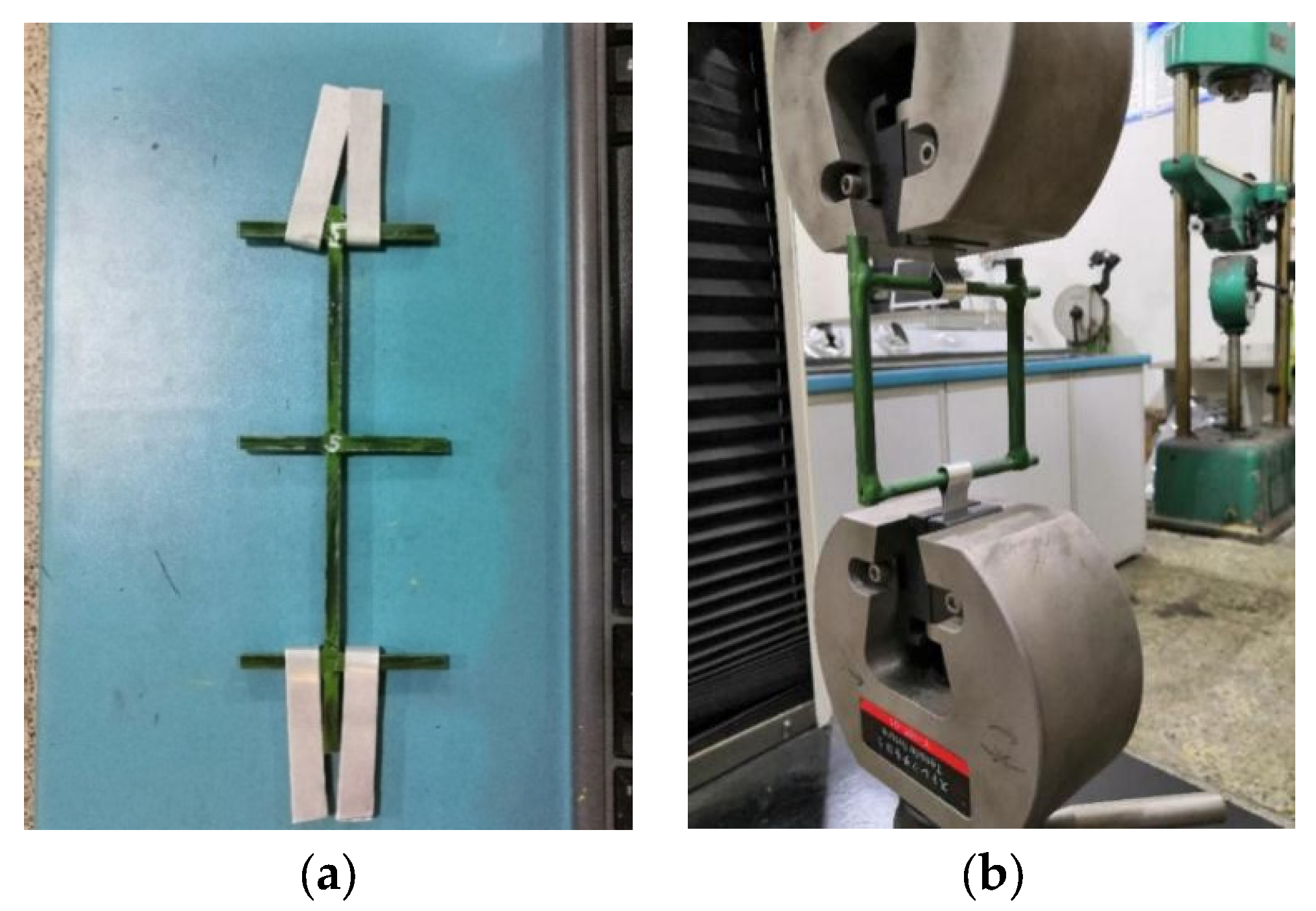
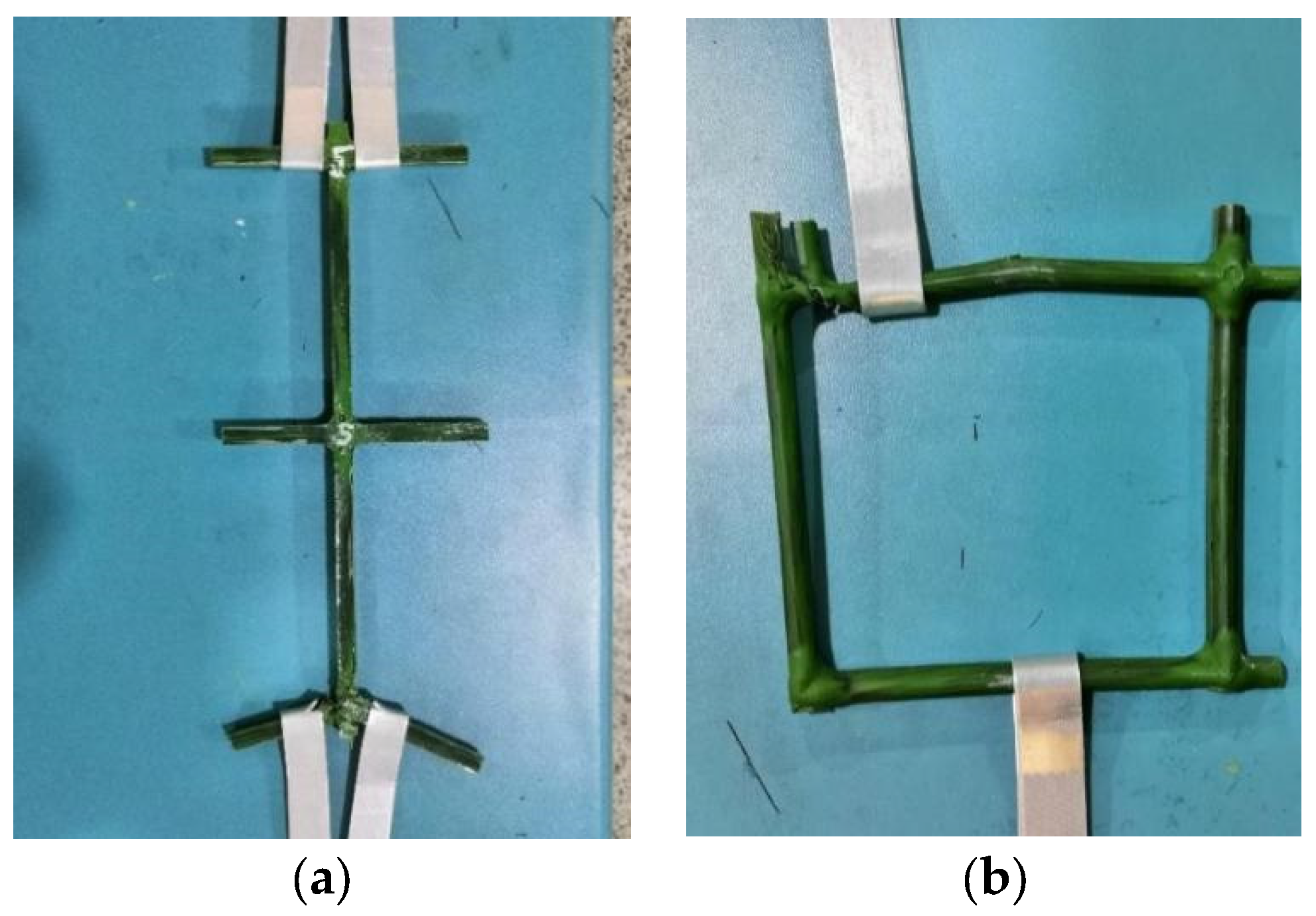

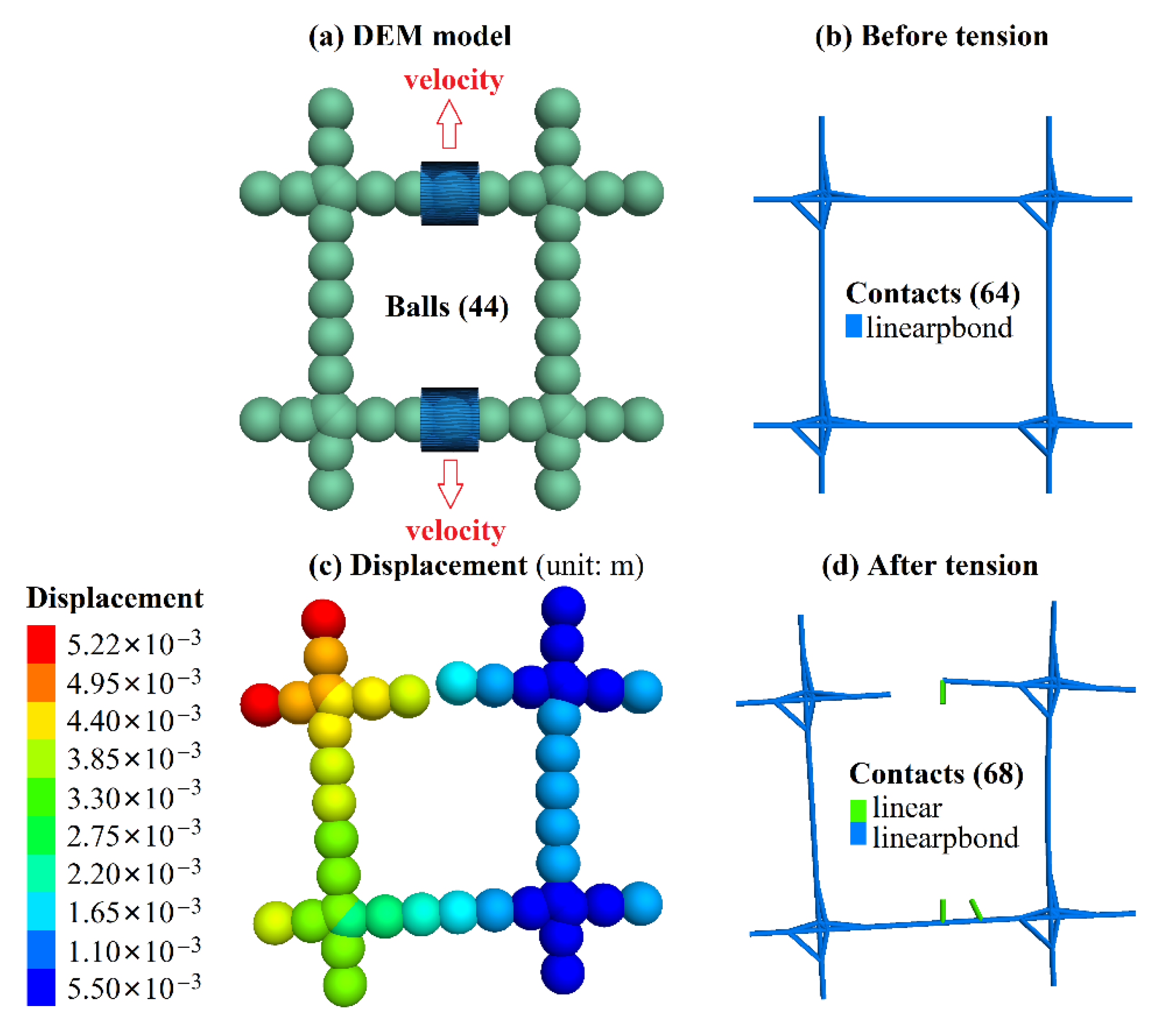







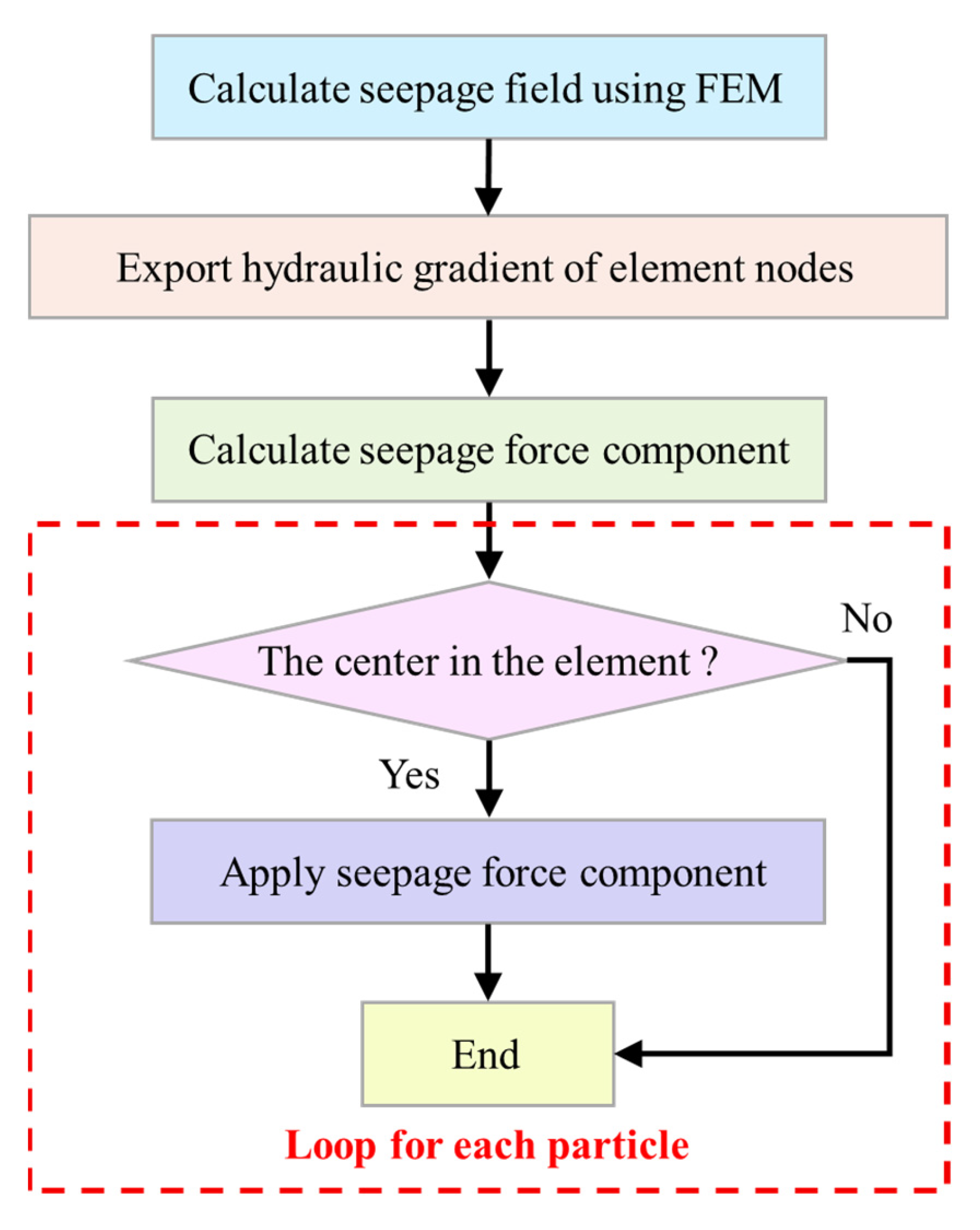





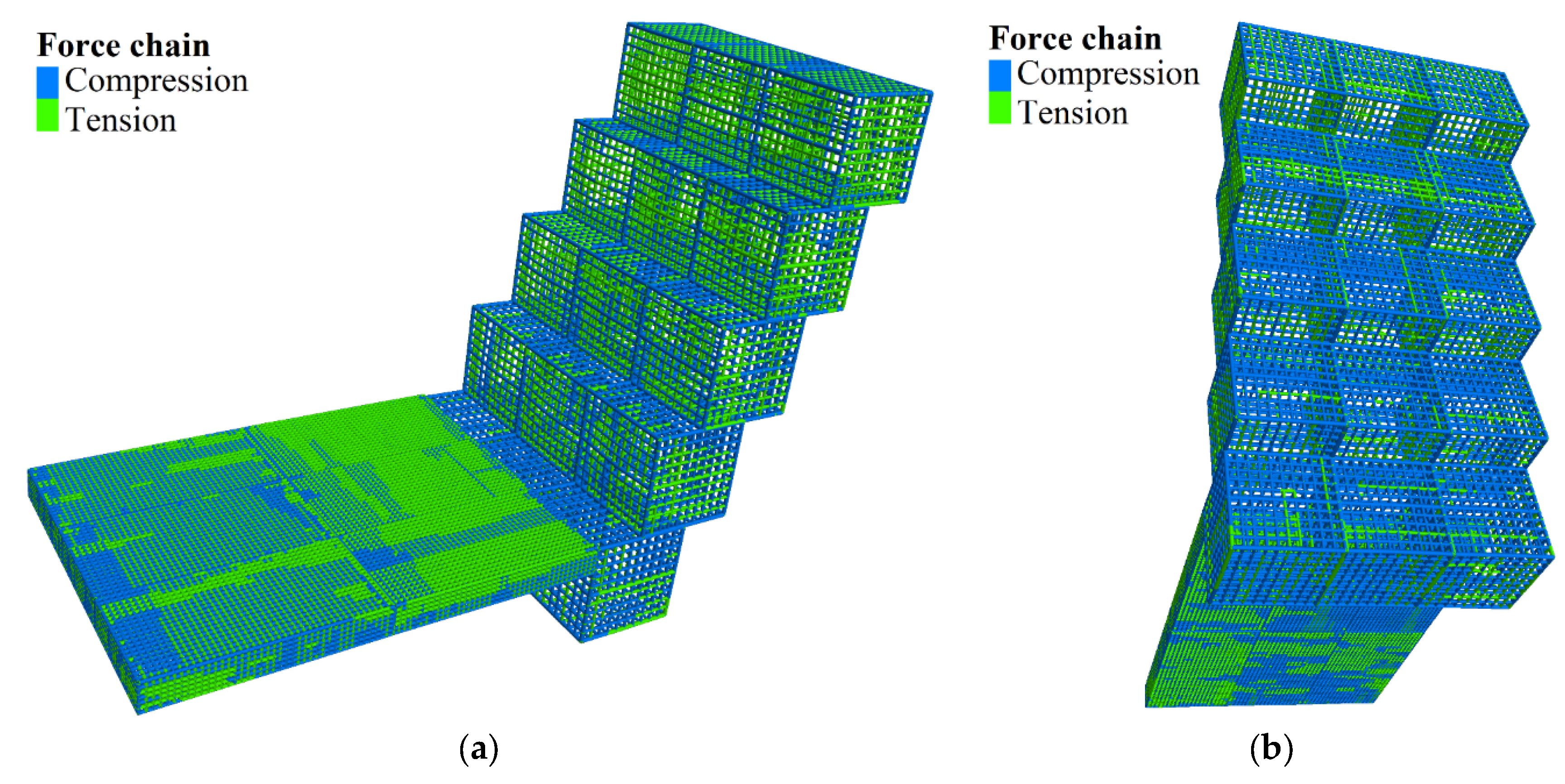


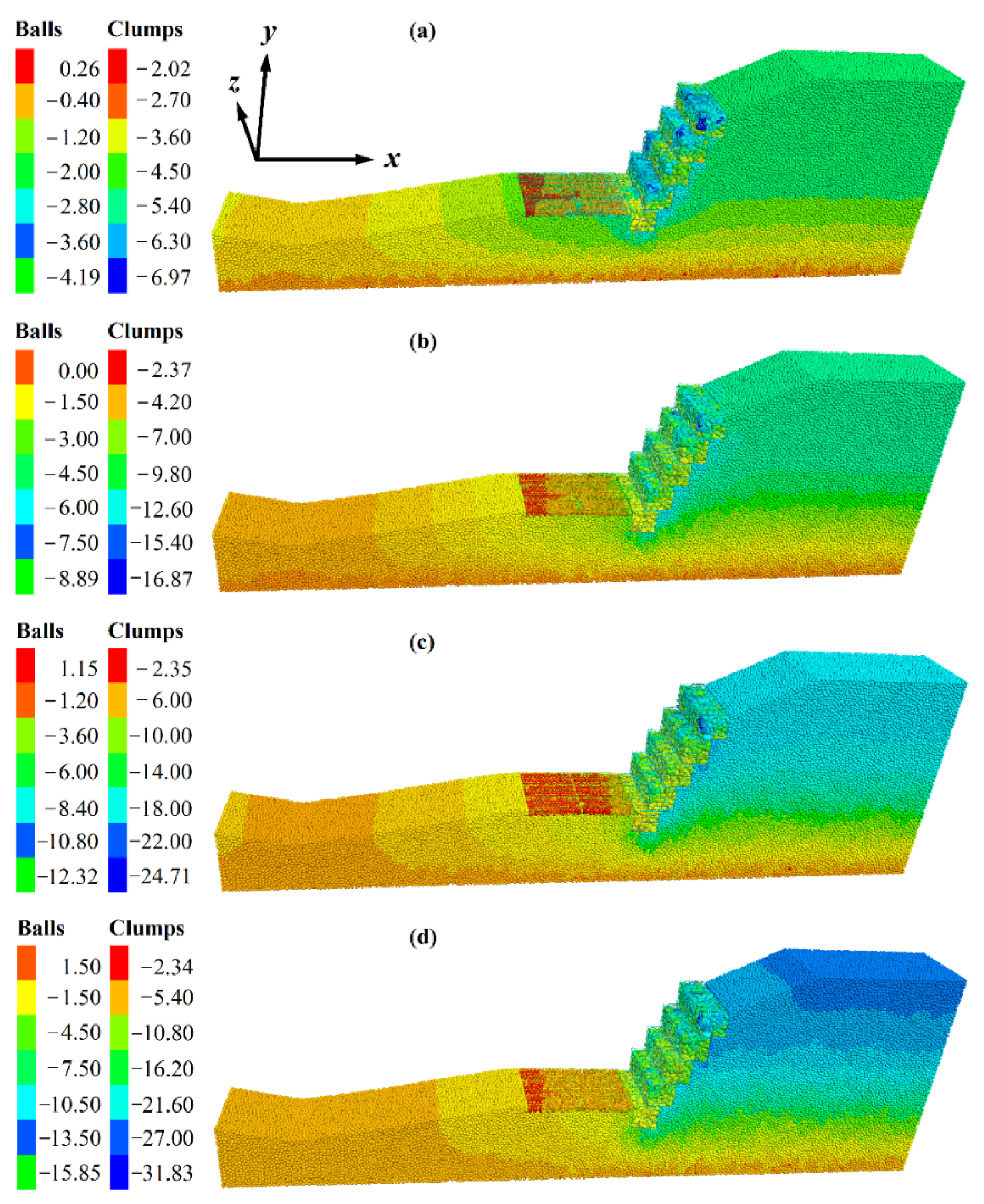

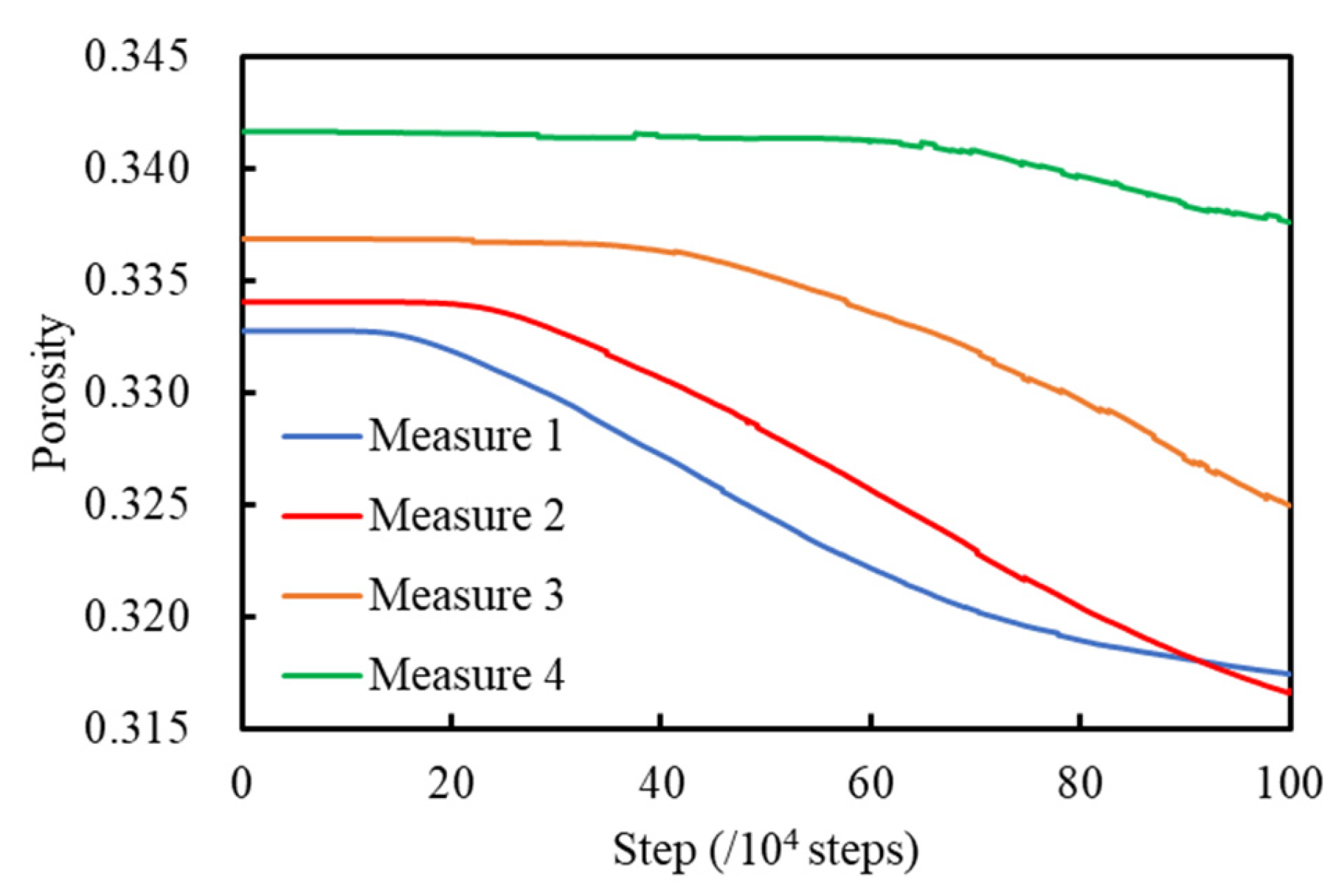


| Sample | Tensile Force (N) | Tensile Strength (MPa) | Breaking Elongation (%) | Results |
|---|---|---|---|---|
| 1 | 2567 | 58 | - | The clamping end was broken and skidded |
| 2 | 5037 | 114 | 5.8 | The same with sample 1 |
| 3 | 7924 | 179 | - | The same with sample 1 |
| 4 | 3810 | 86 | - | Fracture of the head |
| Material | Density (kg/m3) | Friction Angle (°) | Cohesion (kPa) | Elastic Modulus (Pa) | Poisson’s Ratio | Friction Coefficient with Cage |
|---|---|---|---|---|---|---|
| Soil | 1480 | 14 | 15 | 5 × 106 | 0.30 | 0.55 |
| Rock block | 2650 | 60 | 0 | 56 × 109 | 0.20 | - |
| Cage | 2060 | - | - | 50 × 109 | 0.22 | 0.60 |
| Density (kg/m3) | Diameter (m) | Emod (Pa) | Kratio | Fric | pb_ten (Pa) | pb_coh (Pa) | emod * (Pa) | Kratio * |
|---|---|---|---|---|---|---|---|---|
| 2060 | 0.005 | 50 × 109 | 2.0 | 0.2 | 7.9 × 108 | 9.0 × 108 | 50 × 109 | 2.0 |
| Diameter (m) | Diameter (m) | Emod (Pa) | Kratio | Fric | cb_tenf (N) | cb_shearf (N) |
|---|---|---|---|---|---|---|
| 0.10–0.14 | 0.35 | 5 × 106 | 2.0 | 0.06 | 100.0 | 100.0 |
| Contact | Density (kg/m3) | Diameter (m) | Emod (Pa) | Kratio | Fric |
|---|---|---|---|---|---|
| A1 | 2650 | 0.08–0.10 | 56 × 109 | 2.4 | 0.65 |
| A2 | - | - | 2.8 × 107 | 2.0 | 0.35 |
| Contact | Emod (Pa) | Kratio | Fric |
|---|---|---|---|
| C1 | 1.0 × 109 | 1.0 | 0.2 |
| C2 | 50 × 109 | 2.0 | 0.3 |
| C3 | 56 × 109 | 2.0 | 0.3 |
Publisher’s Note: MDPI stays neutral with regard to jurisdictional claims in published maps and institutional affiliations. |
© 2022 by the authors. Licensee MDPI, Basel, Switzerland. This article is an open access article distributed under the terms and conditions of the Creative Commons Attribution (CC BY) license (https://creativecommons.org/licenses/by/4.0/).
Share and Cite
Dai, J.; Xu, X.; Yang, H.; Su, C.; Ye, N. Safety Risk Analysis of a New Design of Basalt Fiber Gabion Slope Based on Improved 3D Discrete Element Method and Monitoring Data. Sensors 2022, 22, 3645. https://doi.org/10.3390/s22103645
Dai J, Xu X, Yang H, Su C, Ye N. Safety Risk Analysis of a New Design of Basalt Fiber Gabion Slope Based on Improved 3D Discrete Element Method and Monitoring Data. Sensors. 2022; 22(10):3645. https://doi.org/10.3390/s22103645
Chicago/Turabian StyleDai, Jianjian, Xiangyang Xu, Hao Yang, Chao Su, and Nan Ye. 2022. "Safety Risk Analysis of a New Design of Basalt Fiber Gabion Slope Based on Improved 3D Discrete Element Method and Monitoring Data" Sensors 22, no. 10: 3645. https://doi.org/10.3390/s22103645






